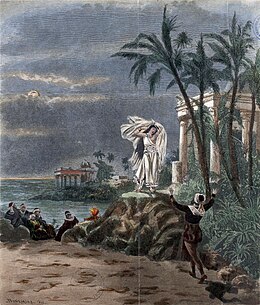Les pêcheurs de perles
| Les pêcheurs de perles | |
|---|---|
| Opera by Georges Bizet | |

Final scene of act 1 (La Scala, 1886)
|
|
| Librettist | |
| Language | French |
| Premiere | 30 September 1863 Théâtre Lyrique, Paris |
Les pêcheurs de perles (The Pearl Fishers) is an opera in three acts by the French composer Georges Bizet, to a libretto by Eugène Cormon and Michel Carré. It was first performed on 30 September 1863 at the Théâtre Lyrique in Paris, and was given 18 performances in its initial run. Set in ancient times on the island of Ceylon, the opera tells the story of how two men's vow of eternal friendship is threatened by their love for the same woman, whose own dilemma is the conflict between secular love and her sacred oath as a priestess. The friendship duet "Au fond du temple saint", generally known as "The Pearl Fishers Duet", is one of the best-known in Western opera.
At the time of the premiere, Bizet (born on 25 October 1838) was not yet 25 years old: he had yet to establish himself in the Parisian musical world. The commission to write Les pêcheurs arose from his standing as a former winner of the prestigious Prix de Rome. Despite a good reception by the public, press reactions to the work were generally hostile and dismissive, although other composers, notably Hector Berlioz, found considerable merit in the music. The opera was not revived in Bizet's lifetime, but from 1886 onwards it was performed with some regularity in Europe and North America, and from the mid-20th century has entered the repertory of opera houses worldwide. Because the autograph score was lost, post-1886 productions were based on amended versions of the score that contained significant departures from the original. Since the 1970s, efforts have been made to reconstruct the score in accordance with Bizet's intentions.
Modern critical opinion has been kinder than that of Bizet's day. Commentators describe the quality of the music as uneven and at times unoriginal, but acknowledge the opera as a work of promise in which Bizet's gifts for melody and evocative instrumentation are clearly evident. They have identified clear foreshadowings of the composer's genius which would culminate, 10 years later, in Carmen. Since 1950 the work has been recorded on numerous occasions, in both the revised and original versions.
...
Wikipedia
